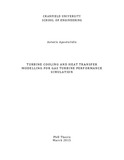JavaScript is disabled for your browser. Some features of this site may not work without it.
| dc.contributor.advisor | Laskaridis, Panagiotis | |
| dc.contributor.advisor | Pilidis, Pericles | |
| dc.contributor.author | Apostolidis, Asteris | |
| dc.date.accessioned | 2015-06-11T13:31:59Z | |
| dc.date.available | 2015-06-11T13:31:59Z | |
| dc.date.issued | 2015-03 | |
| dc.identifier.uri | http://dspace.lib.cranfield.ac.uk/handle/1826/9234 | |
| dc.description.abstract | The successful design of cooling systems for gas turbine engines is a key factor to feasibility of new projects, as the trend for increasing turbine entry temperatures implies requirements for more sophisticated cooling methods. This work focuses on the prediction of cooling performance of turbines, starting from local heat transfer effects at the surface of blades and vanes and expanding to performance simulation of cooled high pressure turbines and engines. In this context, this thesis establishes a new method that investigates the following topics: • The connection between the gas flow field around a cooled blade or vane and the prediction of cooling requirements of the setup. • The connection between a detailed gas flow field around a cooled blade or vane and a preliminary estimation of its metal temperature. • The effect that blade cooling requirements prediction has towards the performance simulation of a cooled turbine and the difference in results between turbine models of different axial resolution. • A simulation platform that includes the aforementioned topics under a web-based gas turbine performance simulation program. The first two objectives are tackled by developing a preliminary cooling design framework, which performs the needed convective and conductive heat transfer calculations between the gas and the blade, the blade and the coolant, and within the blade material. The method divides the geometry into a finite number of volumes, where heat transfer calculations are performed for steady-state conditions. One- and two-dimensional results show a good agreement with previous experimental work. The results suggest that chord resolution for blade heat transfer prediction is essential for a more accurate coolant temperature and mass flow rate prediction. In addition, conduction modelling has a dominant effect in heat transfer prediction of blades with steep temperature gradients. The third objective is achieved by associating the coolant state before mixing with the main stream and the results in turbine performance. The coolant temperature and mass flow rate prediction have a significant impact on turbine work and thermodynamic efficiency, figures highlighted as well for different turbine axial resolution methods. The results suggest that as the coolant heats up through a blade or vane and eventually mixes with the main flow, it contributes significantly towards the predicted turbine work, affecting as well the overall engine performance results, such as specific fuel consumption and specific thrust. A multistage turbine model is most suitable for capturing these effects, but it requires a number of additional inputs. Finally, the thesis suggests that a simulation framework such as the aforementioned, it can be of high usability and applicability if implemented on the cloud, rather than locally installed. | en_UK |
| dc.language.iso | en | en_UK |
| dc.publisher | Cranfield University | en_UK |
| dc.rights | © Cranfield University 2015. All rights reserved. No part of this publication may be reproduced without the written permission of the copyright owner. | en_UK |
| dc.title | Turbine cooling and heat transfer modelling for gas turbine performance simulation | en_UK |
| dc.type | Thesis or dissertation | en_UK |
| dc.type.qualificationlevel | Doctoral | en_UK |
| dc.type.qualificationname | PhD | en_UK |
